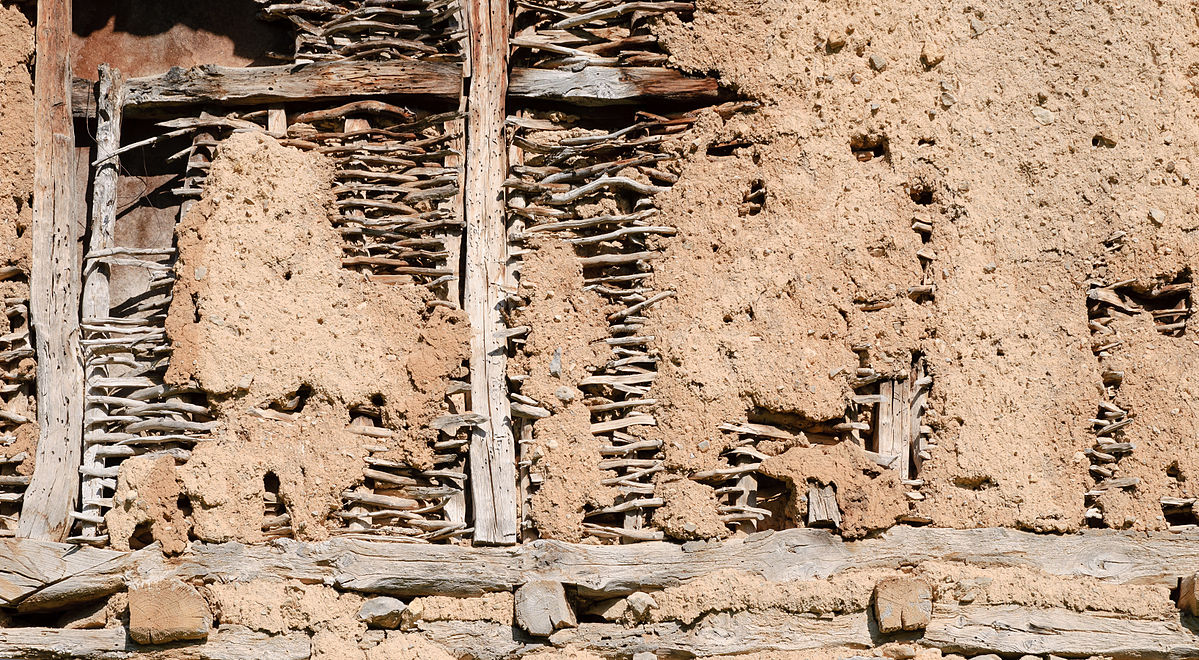Wattle and daub

|
| The old wattle and daub construction system found at the 19th century Razboishte monastery, Bulgaria. By MrPanyGoff [CC BY-SA 3.0 (https://creativecommons.org/licenses/by-sa/3.0)], from Wikimedia Commons |
Wattle and daub is a composite building technique that has be used for wall construction for thousands of years. It consists of a woven lattice (the ‘wattle’) which is daubed with a sticky filler material.
Wattle is typically formed by wooden strips or thin branches woven between upright stakes. Other materials that can be used as wattle include reeds, vines, and bamboo, and it can aso be formed as a loose panels slotted between timber framing.
Daub is typically formed from mud plaster made from a combination of wet soil, clay, sand, animal dung and straw. For more information, see Daub.
Once the daub has been applied to the wattle (sometimes in more than one layer) and left to completely dry, it may be whitewashed to give it better resistance to rain, increase its solar reflectance and enhance its appearance.
Wattle and daub is still used in many regions of the world but in modern architecture it became superseded by lath and plaster for wall and ceiling applications, and more recently by plasterboard. However, it has become more prevalent again with the rise in popularity of sustainable building techniques and materials.
[edit] Related articles on Designing Buildings
Featured articles and news
Retired firefighter cycles world to raise Grenfell funds
Leaving on 14 June 2025 Stephen will raise money for youth and schools through the Grenfell Foundation.
Key points for construction at a glance with industry reactions.
Functionality, visibility and sustainability
The simpler approach to specification.
Architects, architecture, buildings, and inspiration in film
The close ties between makers and the movies, with our long list of suggested viewing.
SELECT three-point plan for action issued to MSPs
Call for Scottish regulation, green skills and recognition of electrotechnical industry as part of a manifesto for Scottish Parliamentary elections.
UCEM becomes the University of the Built Environment
Major milestone in its 106-year history, follows recent merger with London School of Architecture (LSE).
Professional practical experience for Architects in training
The long process to transform the nature of education and professional practical experience in the Architecture profession following recent reports.
A people-first approach to retrofit
Moving away from the destructive paradigm of fabric-first.
International Electrician Day, 10 June 2025
Celebrating the role of electrical engineers from André-Marie Amperè, today and for the future.
New guide for clients launched at Houses of Parliament
'There has never been a more important time for clients to step up and ...ask the right questions'
The impact of recycled slate tiles
Innovation across the decades.
EPC changes for existing buildings
Changes and their context as the new RdSAP methodology comes into use from 15 June.
Skills England publishes Sector skills needs assessments
Priority areas relating to the built environment highlighted and described in brief.
BSRIA HVAC Market Watch - May 2025 Edition
Heat Pump Market Outlook: Policy, Performance & Refrigerant Trends for 2025–2028.
Committing to EDI in construction with CIOB
Built Environment professional bodies deepen commitment to EDI with two new signatories: CIAT and CICES.
Government Grenfell progress report at a glance
Line by line recomendation overview, with links to more details.
An engaging and lively review of his professional life.
Sustainable heating for listed buildings
A problem that needs to be approached intelligently.
50th Golden anniversary ECA Edmundson apprentice award
Deadline for entries has been extended to Friday 27 June, so don't miss out!
CIAT at the London Festival of Architecture
Designing for Everyone: Breaking Barriers in Inclusive Architecture.
Mixed reactions to apprenticeship and skills reform 2025
A 'welcome shift' for some and a 'backwards step' for others.



























